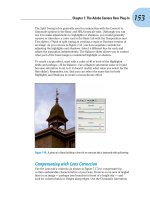Chapter 4 osteocytes
Bạn đang xem bản rút gọn của tài liệu. Xem và tải ngay bản đầy đủ của tài liệu tại đây (260.96 KB, 5 trang )
Chapter 4: Osteocytes
Lynda F. Bonewald
From the Primer on the Metabolic Bone Diseases
and Disorders of Mineral Metabolism, 7th Edition.
www.asbmrprimer.org
Figure 1
Figure 1 The embedding osteocyte retains its connectivity with cells on the bone surface. The image on
the right is of acid-etched plastic embedded murine cortical bone. With this technique, resin fills the lacunocanalicular system, osteoid, and marrow, but cannot penetrate mineral. Mild acid is used to remove the
mineral leaving behind a resin cast relief. Note the canaliculi connecting the lacunae with the bone surface
at the bottom of the image. The image on the right is a from transmission electron microscopy showing a
fully embedded osteocyte and an osteoid-osteocyte becoming surrounded by mineral (white). The osteoid
is black and the osteoblasts are at the bottom of the image.
© 2008 American Society for Bone and Mineral Research
From the Primer on the Metabolic Bone Diseases
and Disorders of Mineral Metabolism, 7th Edition.
www.asbmrprimer.org
Figure 2
Figure 2 The osteocyte lacuno-canalicular network is intimately associated with the blood vessel network
in the bone matrix. The white marker points to an osteocyte lacunae intimately associated with the blood
vessel.
© 2008 American Society for Bone and Mineral Research
From the Primer on the Metabolic Bone Diseases
and Disorders of Mineral Metabolism, 7th Edition.
www.asbmrprimer.org
Figure 3
Figure 3 Osteocytes as orchestrators of bone (re)modeling. Osteocytes play a role in bone formation and
mineralization as promoters of mineralization (such as Dmp1 and Phex) and inhibitors of mineralization and
bone formation (such as Sost/sclerostin and MEPE/OF45) are highly expressed in osteocytes (top). These
supporters and inhibitors of bone formation and mineralization are most likely exquisitely balanced to
maintain equilibrium to maintain bone mass. Osteocytes also appear to play a major role in the regulation
of osteoclasts, by both inhibiting and activating osteoclastic resorption. It has recently been shown that with
loading, the osteocytes send signals inhibiting osteoclast activation (bottom). In contrast, compromised,
hypoxic, apoptotic or dying osteocytes especially with unloading appear to send unknown signals to
osteoclasts/preosteoclasts on the bone surface to initiate resorption. Therefore, osteocytes within the bone
regulate bone formation and mineralization and inhibit osteoclastic resorption, whereas having the capacity
to also send signals of osteoclast activation under specific conditions.
© 2008 American Society for Bone and Mineral Research
From the Primer on the Metabolic Bone Diseases
and Disorders of Mineral Metabolism, 7th Edition.
www.asbmrprimer.org
Table 1: Osteocyte Markers
© 2008 American Society for Bone and Mineral Research









